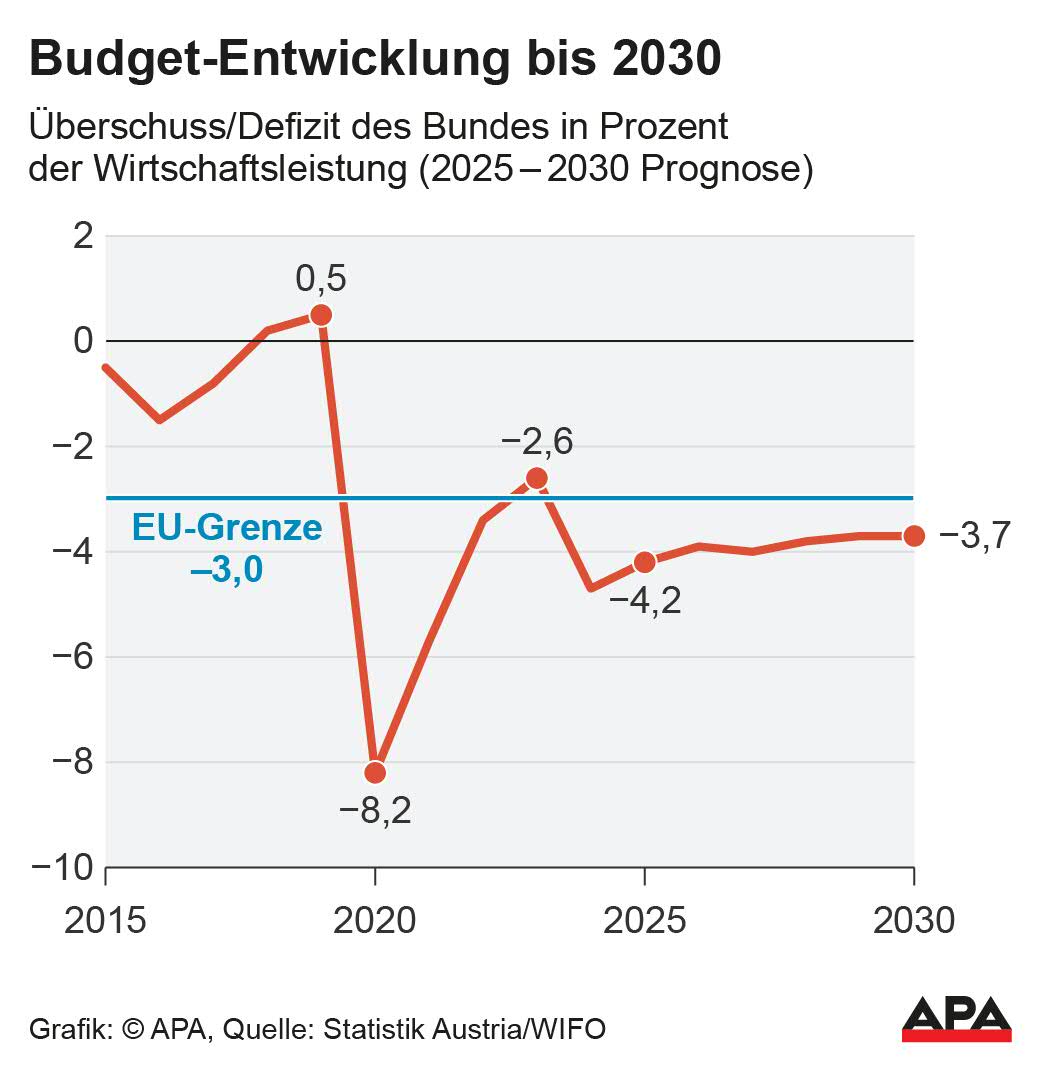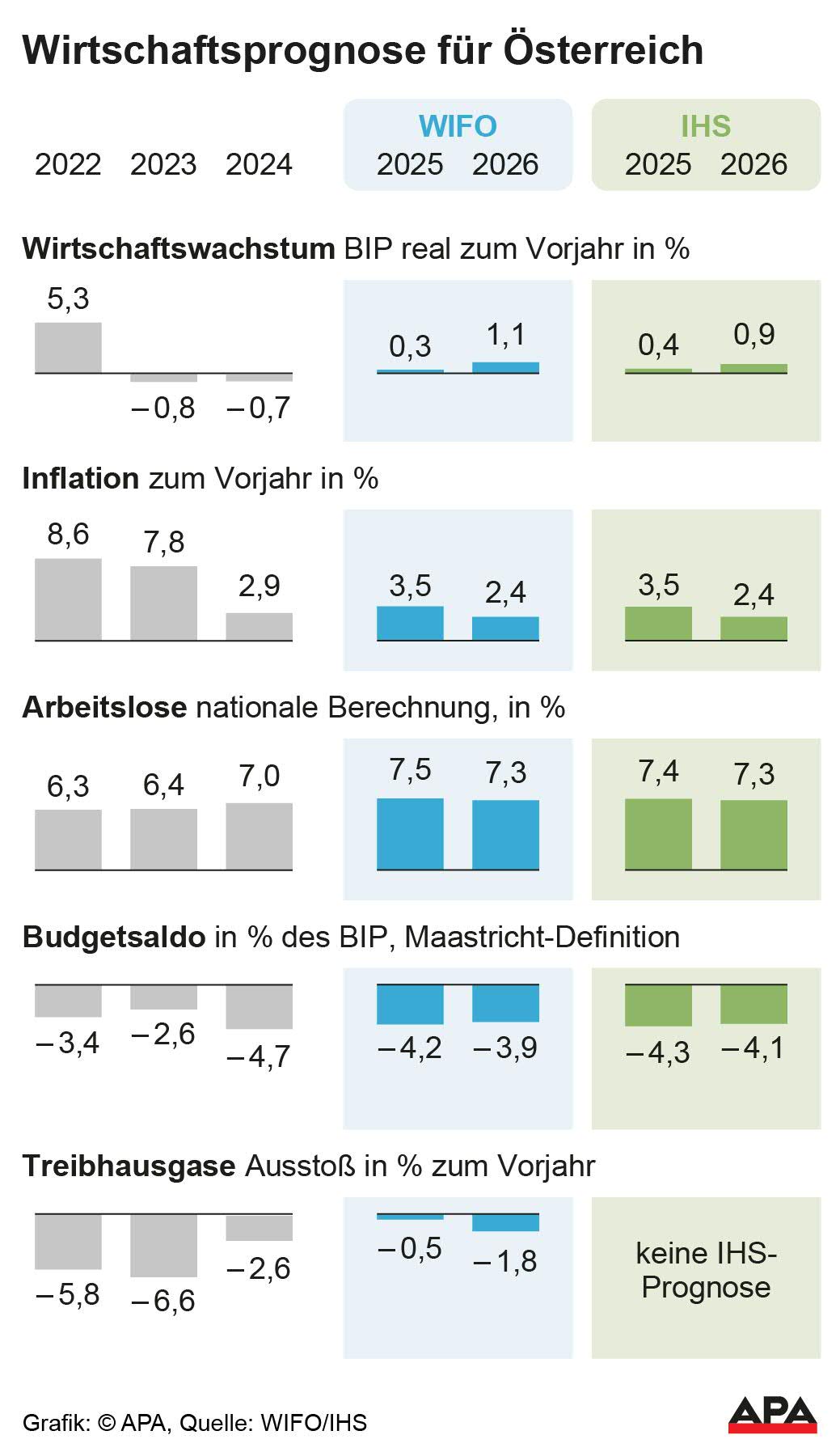Österreich überwindet Rezession, aber Inflation bleibt hoch

The economic researchers from Wifo and IHS are raising their economic forecast for the current year. In June, Austria's economy was expected to have zero growth (Wifo) or a "mini" plus (IHS) of 0.1 percent, but now a plus of 0.3 or 0.4 percent is expected. The longest economic downturn of the Second Republic would thus be history. However, the economists are significantly raising the inflation forecast for this year.
Consumption as a Driver
The economic recovery will be supported by private consumption, but foreign trade in goods is still declining this year, explained Wifo. The economic dynamics are expected to "significantly lag behind earlier recovery phases" in 2025/2026, according to IHS, citing "the subdued international economy and domestic structural problems." For 2026, the economists lowered their economic growth forecast from June by 0.1 percentage points to 1.1 or 0.9 percent. In 2023, the real gross domestic product (GDP) in Austria shrank by 0.8 percent and in 2024 by 0.7 percent.

Inflation of 3.5 Percent Expected This Year
After the record inflation years of 2022 and 2023 with 8.6 percent and 7.8 percent, inflation fell to 2.9 percent in 2024. However, the sideways movement in inflation expected by Wifo and IHS has not occurred this year, with both institutes now expecting 3.5 percent for the current year. In recent months, food prices have "increased significantly" and contrary to expectations, the price pressure on labor-intensive services has not eased, according to IHS. Next year, Wifo and IHS forecast a decline in inflation to 2.4 percent.

The economic recovery is reaching the labor market with a delay: For this year, economists expected an increase in the unemployment rate by national calculation by 0.5 or 0.4 percentage points to 7.5 (Wifo) or 7.4 percent (IHS). Next year, the unemployment rate is expected to fall to 7.3 percent.
Growth Below Eurozone Level
Das Wifo veröffentlichte mit der Kurzfrist-Konjunkturprognose erstmals zeitgleich auch die Mittelfristprognose. Das reale BIP-Wachstum im Zeitraum 2026 bis 2030 soll im Durchschnitt 1,1 Prozent pro Jahr betragen. Die österreichische Wirtschaft dürfte laut Wifo mittelfristig um 0,2 Prozentpunkte schwächer wachsen als der Durchschnitt des Euroraums.
Wifo/IHS bei Budgetdefizit 2025 etwas optimistischer als Marterbauer
Wifo und IHS prognostizieren zudem für heuer ein gesamtstaatliches Defizit von 4,2 bzw. 4,3 Prozent der Wirtschaftsleistung und von 3,9 bzw. 4,1 Prozent im kommenden Jahr. Finanzminister Markus Marterbauer (SPÖ) ist etwas pessimistischer und meldete vergangene Woche für 2025 ein erwartetes Budgetdefizit von 4,54 Prozent an die EU.
Das gesamtstaatliche Defizit in Österreich lag 2024 mit 4,7 Prozent des Bruttoinlandsprodukts (BIP) deutlich über dem Maastricht-Grenzwert von 3 Prozent. Im Juli wurde deswegen die Eröffnung eines EU-Defizitverfahrens gegen Österreich offiziell beschlossen.
"Beträchtlichen Unsicherheiten" bei Budget der Länder und Gemeinden
Die Prognose der Budgetentwicklung auf Ebene der Länder und Gemeinden sei "mit beträchtlichen Unsicherheiten verbunden", warnte das IHS in seinem Konjunkturbericht. Beschlossene Sparmaßnahmen würden die Budgets ab der zweiten Jahreshälfte 2025 entlasten. Das Wifo rechnet für 2025 mit ausgabenseitigen Einsparungen der öffentlichen Hand von knapp 3,5 Mrd. Euro, unter anderem durch die Streichung des Klimabonus und der Aussetzung der Bildungskarenz.
In der Langfristprognose des Wifo sinkt das gemeinsame Defizit von Bund, Länder, Gemeinden und Sozialversicherungsträgern bis 2030 nur langsam auf 3,7 Prozent. Das Budgetdefizit des Staates soll im Zeitraum 2026 bis 2030 bei durchschnittlich 3,8 Prozent des nominellen BIP liegen und die Staatsschuld bis 2030 auf 88,3 Prozent der nominellen Wirtschaftsleistung steigen. Österreich würde damit bis Ende des Jahrzehnts gegen die Maastricht-Schuldenregeln der EU verstoßen.
(APA/Red)
This article has been automatically translated, read the original article here.
Du hast einen Hinweis für uns? Oder einen Insider-Tipp, was bei dir in der Gegend gerade passiert? Dann melde dich bei uns, damit wir darüber berichten können.
Wir gehen allen Hinweisen nach, die wir erhalten. Und damit wir schon einen Vorgeschmack und einen guten Überblick bekommen, freuen wir uns über Fotos, Videos oder Texte. Einfach das Formular unten ausfüllen und schon landet dein Tipp bei uns in der Redaktion.
Alternativ kannst du uns direkt über WhatsApp kontaktieren: Zum WhatsApp Chat
Herzlichen Dank für deine Zusendung.



